By Alex Boag-Wyllie, Marketing Assistant
Published: Mar 17, 2020More by Alex


By Alex Boag-Wyllie, Marketing Assistant
Published: Mar 17, 2020More by Alex
Ask anyone, and they’ll likely tell you that Scotland is known for its wild mountains, the Loch Ness Monster, kilts and whisky. Ireland is famous for rainy weather, leprechauns, and large quantities of pubs (perfect for escaping that rain!). Say England, and you probably think of cups of tea, the king, and pretty pastoral landscapes. Wales brings to mind dramatic landscapes bright with daffodils and dotted with sheep, while beautiful singing lifts the soul.
![]()
With soaring mountains and dramatic highlands teeming with wildlife, Scotland is a country full to the brim with the outdoors. Vast sweeps of wildland are inhabited only by deer, eagles, hares and other Highland wildlife. Much of the Scottish Highlands and islands are remote, eerie and hauntingly beautiful, while the southern half of the country is comprised of the rolling and lush Lowlands, where the vast majority of the population resides. In Scotland, large mountains are measured as Munros (3,000+ feet or 914+ metres) and Corbetts (2,500-3,000 feet/762-914 metres). 282 Scottish mountains are Munros, with a further 221 classifying as Corbetts. Large swathes of Scotland are covered in high mountains – it’s in the name, the Scottish Highlands.
In comparison, Ireland is an island to the west of the UK. Most of the island is rural countryside, and the mountains of Ireland are smaller, and the coastlines are less remote. In Ireland, there are barely more than a handful of mountains – there are only 13 Furths (called Munros over in Scotland), and 23 mountains within the Corbett range. Most of Ireland’s mountains are concentrated on the west coast, particularly in Kerry, Connemara, Mayo and Donegal.
England is the part of the UK that usually comes to mind when thinking of the British countryside. This is a country known for its rolling hills, ancient castles and stately homes. Only three peaks – Scafell Pike, Helvellyn, and Skiddaw – actually qualify as “Munros”. In England, there isn’t really a corresponding term for tall mountains, preferring instead to recognise regions known for their upland beauty, such as the Lake District, the Pennines, the Cheviot Hills, and the Peak District. The southwest is known more for its gently rolling hills.
Amidst the captivating landscapes of Wales, mountains stand tall. Majestic sentinels beckoning to adventurers, these peaks offer an exhilarating playground. From Yr Wyddfa (Snowdon) to the Bannau Brycheiniog (Brecon Beacons), these mountains are a dramatic tapestry to explore. Carved out during the Ice Age, the Cambrian mountains offer some of the last true wilderness in southern Britain. Whether you’re an avid hiker seeking panoramic views or prefer daring descents on a mountain bike, Wales is your stage. As you navigate their rugged winding trails, encounter cascading waterfalls, ancient woodlands, and hidden valleys that unveil the true essence of Wales.
“The mountains are calling and I must go.”
―
Despite the smaller mountains, Ireland is not short on rugged, wild terrain. Most of the country is rural; Dublin, Belfast, Derry, Galway, Limerick and Cork are the only cities, and they are small by US standards.
Most Irish people like spending time outdoors. Unlike the manicured US parks where clearcut trails and bright trailblazers make hiking for the casual walker relatively tame and mud-free, Ireland is a wet and boggy country. There are few trails (often maintained by Coillte, Ireland’s forestry service), and most of the trails that do exist are fairly short. Or else, they are wet, narrow sheep tracks that require an OS map and basic navigation skills. A lot of the coolest places in Ireland don’t have a way-marked trail – visiting them will mean pulling on your trusty hiking boots and squelching through the mud.
This is quite similar to Scotland, where a fair bit of mud-squelching will be required. In Scotland, the Right to Roam initiative gives walkers the right to walk (almost) anywhere in Scotland. Scotland has a lot of trails, and public access to the land is very important. Organisations like Forestry and Land Scotland and John Muir Trust invest heavily in path building and maintenance, and managed estates build specific walking and biking trails across their lands. This widens access to Scotland’s most beautiful places to anyone with a sturdy set of boots and waterproofs while limiting the damage done by recreational use. Scotland’s Right to Roam allows walkers and any other non-motorised pursuits the freedom to emjoy Scotland, as long as they adhere to the Scottish Outdoor Access code. It may seem contradictory but the built paths encourage people to respect the environment and play a large role in outdoor sustainability.
The Right to Roam initiative doesn’t exist in Ireland, England or Wales. However, the Countryside and Rights of Way Acts in the early 2000s grants public rights of access to common land and open countryside in England and Wales. This extends only to walking, not to activities that may damage the land, such as biking and camping. Always follow a few ground rules, including:
Many churches, Neolithic tombs, castle ruins, and other cultural sites require a bit of off-trail walking. Make sure you pack those trusty boots, gaiters and waterproofs (Hiking boot or shoe? Learn the difference.).
What To Wear in Ireland What to Wear in Scotland What to Wear in England & Wales
In all five countries, you can spot dozens of types of coastal birds – mostly seabirds – such as razorbills, gannets, fulmars and guillemots. Adorable puffins arrive from April to June for the breeding season. Spot them on Scottish islands, in northern England, and along the coast of Wales and Ireland. In Scotland, you might be lucky enough to spot sea eagles. Marine wildlife such as whales, dolphins, basking sharks and seals live off the shores of the United Kingdom and Ireland. The coastal marshlands of England are also home to several rare birds to try and catch a glimpse of. The coast of Wales also offers a haven for marine wildlife. A farmer discovered the largest recorded leatherback turtle on Harlech Beach, on the edge of the Eryri (Snowdonia) National Park, in the 1980s.
Inland wildlife is where Scotland, Ireland, England and Wales differ. While you can spot some deer and stags in Ireland – particularly in Killarney, Wicklow and Glenveagh National Parks – the best place to see magnificent stags is in the Scottish Highlands. The mating season during autumn is the best time for spotting deer in Scotland, as the males begin to rut. Spotting the elusive red squirrel is better in Scotland too, as there are larger expanses of land – keep your eyes out for birds of prey such as golden eagles, goshawks, peregrine falcons, osprey, owls and more. In England and Wales, you’re more likely to spot smaller critters, from numerous birds to squirrels, mountain hares, beavers and otters.
Rewilding is a recent trend in Scotland, championed by billionaire Danish investor, Anders Povlsen, who is the largest private landowner in Scotland after the Royals. He is trying to rewild Scotland by planting trees, protecting large swathes of land, and bringing back wild animals and their natural habitats. On his estates, the grazing of sheep and deer is limited to allow the native woodland flora and fauna to regenerate.
These projects should support threatened species in Scotland like the wildcat, the golden eagle, osprey, and capercaillie. However, this is at the expense of the massive red deer populations that have long dominated the Highlands, their presence propagated by estate owners for hunting and shooting. Rewilding has also raised the topic of reintroducing wolves and lynx to Scotland, where both these animals used to roam the hills freely. These talks are, at present, largely theoretical.
There are also a number of rewilding projects in England, where overfarmed land is being returned to its former state. This has allowed old habitats to be re-established, such as marshland and woodland. Look out for great rewilding work in Suffolk and at Wild Ennerdale in Cumbria, to name a few locations. Wild Nephin is a great example of similar rewilding taking place in Ireland.
But what really makes Ireland so special? It’s the fascinating local characters. A large part of Ireland’s charm is the people who inhabit its emerald hills and sandy shores – the storytellers and farmers, the foragers and adventurers, and the writers, artisans and musicians. Ireland is also rich in tradition, stories and myths perpetuated by those who call this little island home.
In Kerry, walk along the shore or take to the waves with a passionate seaweed forager and fisherman. In Dingle, join a woodworker in his workshop to learn about woodcraft – and his unconventional childhood. On the Aran Islands, say hello to a herd of goats and their story-telling shepherd/ cheese-maker. Explore the rocky hills of Connemara with a renowned archaeologist who brings 5,000-year-old communities and the stories of their people’s lives. Head to one of Ireland’s three fjords to taste the oysters of a Dubliner-turned-oyster farmer.
Head north to County Mayo to explore and learn about dark skies, stars and planets under the tutelage of the founder and longtime stargazer of Mayo Dark Skies. Kayak under the stars in the gentle lakes of Sligo with a cheery South African. Meet a Donegal man still hand-weaving tweed on a traditional loom, and another soaring to new heights atop forgotten sea stacks. Meander the streets of Belfast with history-loving cab drivers keen to show the Belfast of old and new.
On the surface, Ireland is a small, lush, rural island which gets a fair bit of rain (which is what makes it so lush – it’s not called the Emerald Isle for nothing). But the true strength of Ireland is its people who, despite all odds, continue to be some of the most cheery, hospitable and happy-go-lucky people in all of Europe. Generally, the Irish are always ready to invite you into their homes for a cup of tea and plate of scones, or perhaps a hot whiskey.
![]()
Where Ireland is known for warm hospitality and local characters, England is known for its mannerisms and the royal family. This does not mean that the English are not welcoming and unique, but the British Royal Family has become a major tourist attraction for people visiting England. Visitor attractions tied to the Royal family see more visitors than those without a stately connection, and royalty-related merchandise outperforms other types of memorabilia.
People are fascinated by the Royal Family, and their lifestyles spark a lot of intrigue. This has been much assisted by the media – ultimately we all love a good fairytale. The British Royal family have cultivated and glamorised their image carefully to inspire fantasy and escapism for the masses.
Only in Scotland can you have as varied experiences such as swimming with huge basking sharks before learning how to prepare Scottish-North African fusion cuisine under the tutelage of an award-winning cook and food writer, or even attend the world’s largest cultural festival. Scotland sure is a pretty special place…
![]()
In 2019, Scotland’s tourist board launched a new campaign, ‘Only in Scotland’. It aimed to highlight all of the incredible experiences available here which are unique to Scotland. Scotland hardly needs a dedicated marketing campaign to showcase the distinctive and memorable activities on offer in our opinion – they speak for themselves!
Only in Scotland can you go swimming with huge basking sharks and curious seals in crystal clear waters and along white sandy beaches. Only in Scotland can you learn to prepare Scottish-North African fusion cuisine under the tutelage of award-winning cook and food writer Ghillie Basan, all the while enjoying breathtaking views of the Cairngorms from her remote cottage. It’s only here that you can attend the world’s largest cultural festival, and immerse yourself in music, arts, comedy, theatre and more, all in one place. On a smaller scale, it’s only in Scotland that you can go for a walk in the woods and spot local wildlife with someone whose family has lived there for generations and who knows just where to look for the most delicious berries or the best chance to see a Highland stag up close.
With our sparsely populated wild spaces, turn to the skies at night and see the stars as you’ve never seen them before. Taste North Atlantic Salmon prepared by an acclaimed chef, freshly caught on the Isle of Skye. Take in the landscapes that inspired countless authors to write globally acknowledged masterpieces like Sir Walter Scott, Robert Burns, J.M Barrie, Nan Shepherd, Virginia Woolf, Beatrix Potter, George Orwell, J.K Rowling, and Diana Gabaldon.
While Scotland, Ireland and England all offer impressive castles, none compare to those in Wales. Boasting more castles per square mile than any other country in the world, Wales offers visitors over 400 castles to explore. These architectural marvels capture a bygone era when knights and kings roamed their hallowed halls. From towering defences to romantic ruins, every castle offers a unique tale to tell.
![]()
The Castles and Town Walls of King Edward in Gwynedd are a spectacular starting point. Including the castles of Beaumaris, Harlech (pictured), Caernarfon and Conwy, this UNESCO World Heritage Site stretches around the coast of northwest Wales. Their towering fortifications transport visitors back to a time when English kings and Welsh princes vied for dominance.
It would be impossible to list every castle in the country. However, some of our favourites include the iconic Cardiff Castle, Powis’s gardens, and Raglan’s architecture.
As you explore the castle of Wales, discover a rich tapestry of history, legends and architectural splendour. This truly sets Wales apart from the rest of the UK and Ireland. Nestled in lush valleys and perched atop dramatic hilltops, immerse yourself in this world of chivalry and intrigue.
The small communities of Ireland act as bastions to Irish traditions – vibrant music, a rich pantheon of mythology, and the Irish language. Irish trad music is one of the few Irish stereotypes that is completely true. The Irish love a good trad music session as much as anyone. Irish trad music comprises a few core instruments such as the harp, the fiddle, the tin whistle, the bodhran (a type of drum), the bouzouki (guitar-banjo cross), the Uillean pipes (the Irish version of Scottish bagpipes), and more recently, the guitar. Irish folk songs continue to be sung and re-sung, though new songs are written all the time. Bands are often locals, and the venue is cosy Irish pubs. When there is music on, expect the pub to be lively and full.
One difference to the common idea of Irish trad music is the timing. Many visitors expect the live music to be around dinner time, but in Ireland, music comes well after dinner. Don’t expect Irish trad music sessions to start until at least 9:30 pm, and often later.
Scotland is known for its bagpipes, usually played by a fella in a kilt, right?
Scottish music is more than just bagpipes. In Scotland, traditional music has made quite a comeback over the last 20 years. There are various music festivals taking place across the country, and folk music is the live music performance of choice at many pubs. Traditional Scottish music often features the fiddle (violin), guitar, drums, mandolins, harp, accordion and, of course, bagpipes.
This music lends itself perfectly to dancing and is the music of choice for ceilidhs (pronounced kay-lees). Ceilidhs are a popular Scottish country dance. A ceilidh involves several set dances with one or more partners. These events are massively popular at the moment. In Scotland, big events like weddings, galas, and fundraisers aren’t complete without at least a round of ‘Strip the Willow’.
Scotland and Ireland both have a strong connection to music, and you can probably think of at least one tune associated with each country. English folk music might be lesser known, but it should not be overlooked. Like all good folk music, many of these songs tell a story. Expect lost love, sailors’ adventures and country fairs to feature heavily in English folk, set to the music of concertinas, hornpipes, violins and other string instruments.
English musicians are perhaps better known in the pop genre, for example, The Beatles, Kate Bush and Take That.
There is a well-known stereotype that Welsh people are great singers. While not fact, the rich musical tradition of the country, paired with the lyricism of Welsh, combines into powerful music.
Welsh music is rooted in a rich cultural heritage, a vibrant tapestry of ancient traditions and contemporary expression. Intrinsically linked to its Celtic siblings, Welsh music has a distinctive heart that makes it its own unique and beautiful style. Where Scotland has bagpipes and Ireland the bouzouki, Welsh music soars on the waves of the triple harp. Widely considered the national instrument, the Welsh harp arrived from continental Europe in the 1600s. Evolving into a truly Welsh instrument, the harp features three rows of strings instead of the one found on a pedal harp.
Welsh music can be seen at its finest at an eisteddfod. A festival of poetry, music, and culture, these events occur across the country and beyond annually. Celebrating the Welsh language, these events are a profound connection to Welsh culture.
Welsh music extends beyond the traditional from Tom Jones to Shirley Bassey, Bonnie Tyler to Katherine Jenkins. Yet Wales boasts a musical heritage as enchanting as the landscapes that inspire it.
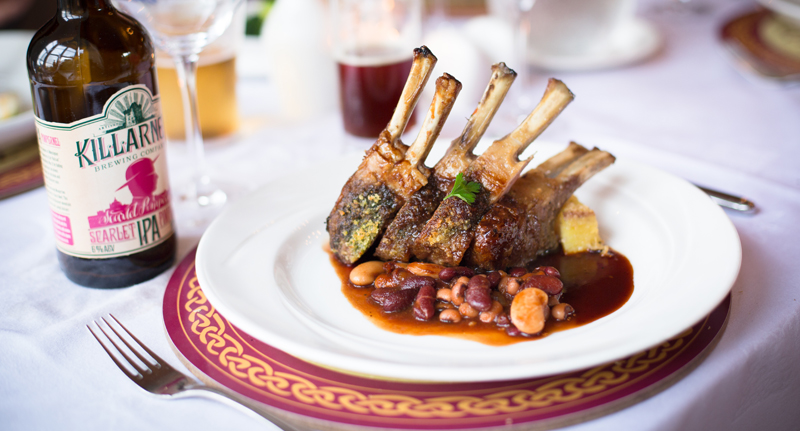
When thinking about Irish cuisine, most people think of spuds, cabbage and pints of Guinness. The Emerald Isle has an up-and-coming foodie culture, with certain places like Belfast, Sligo, Kenmare and Kinsale leading the charge. This recent culinary interest makes the emphasis on organic cooking, creative menus, farm-to-fork cuisine and fresh ingredients make for amazing food.
While you’re in Ireland, be sure to try some of the local cheeses. West Cork in particular has some delicious cheeses like Gubbeen, Durrus, Knockatee cheddar and Coolea gouda. Irish meat is also fantastic and usually organic – there is plenty to taste, from traditional meat dishes like lamb stew, bacon-and-cabbage, and steak and Guinness pie, to new dishes like curries.
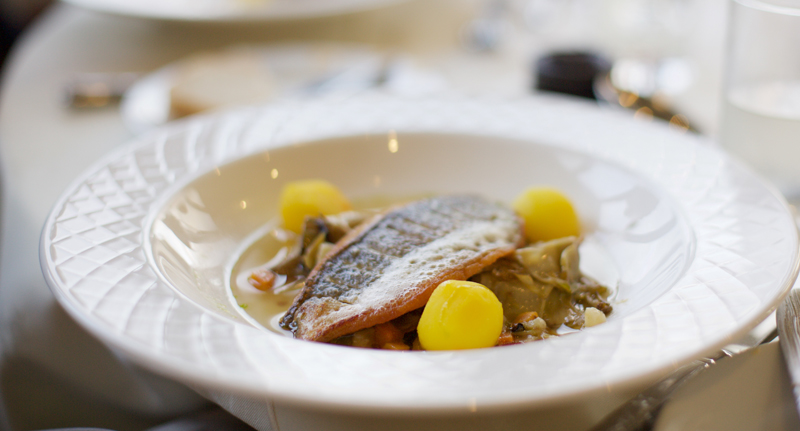
Many people dismiss Scottish cuisine, thinking it is not much more than haggis and tatties. Like Ireland, Scotland has seen a recent food revolution that really takes advantage of the natural larder. Scotland has access to an abundance of fresh and varied seafood, game, fruit, and vegetables.
The North Atlantic salmon is globally recognised as some of the best salmon in the world. On land, famed Highland beef is considered some of the highest quality beef throughout Europe. Locally sourced wild venison is not to be missed either on your next visit to Scotland. Lovers of red meat will be delighted to learn that venison is the healthier option too, being both low fat and high in protein – not to mention mouth-wateringly delicious.
The English do, indeed, love to drink tea. It’s a stereotype that the English like their tea, but it’s undeniably true. Popularised in the 18th century, tea soon became a fashionable commodity. Today, tea is still an essential part of life and is known to fix all problems – tired? stressed? hot? cold? can’t sleep? Drink tea! For a fancy tea experience, go out for Afternoon tea, where tea is served with sandwiches, traybakes and scones.
The English also have more traditional dishes, which are usually hearty and heavy. Look out for fish and chips, bangers and mash (sausages and mashed potatoes), Sunday roasts, and full English breakfasts. English cuisine has been evolving recently as people from all over the world have come to England, bringing their tastes – and cooking skills – with them. While pub food is still delicious and readily available across England, more types of dishes and restaurants are there to be enjoyed.
![]()
Welsh cuisine extends beyond the melting cheesy goodness of Welsh rarebit. Popular savoury dishes often feature the national emblem of Wales, the leek. Whether served as a side dish with lashings of fresh butter or wrapped up alongside cheese and breadcrumbs in a Glamorgan sausage, the humble leek shines in Welsh cooking. Other traditional savoury foods take inspiration from Wales’ extensive coast, including cockles. These small edible bivalves are often served with laverbread. Laverbread is a paste-like delicacy made from laver seaweed.
Welsh sweet treats are the perfect accompaniment to a cup of tea. Bara brith is a spiced fruit cake flavoured with tea, delicious served on its own fresh or toasted with butter. Another iconic Welsh bake is Welsh cakes. Not dissimilar to a scone, these sweetbreads are flatter than their English cousin. Both pair nicely with fresh fruit jam.
Discover the delicacies to look out for on this iconic trail across northern England.
Learn MoreFind out why Ireland is for foodies and see Ireland’s most exciting food-related experiences.
Learn MoreOur pick of Scotland’s best Highland restaurants that show off the real taste of Scotland.
Learn MoreDiscover the food and drink revolution that has taken the island by storm in recent years.
Learn MoreOne of Europe’s oldest distilled beverages, Ireland has long been known for its whiskey (with an ‘e’), supposedly brought to Ireland by medieval monks. Irish whiskey was once the world’s first choice for spirits, and it is still world famous. The Irish for whiskey, uisce beatha, is well-known throughout Ireland. Irish whiskey is protected by the European Geographical Indication and there are a whole list of criteria for Irish whiskey to be, well, Irish – with distillation, production and labelling in Ireland being the most important.
Despite some decline in centuries past, it has seen a recent resurgence. The main brands are Old Bushmills, Jameson, Powers, Redbreast, Teeling and Tullamore, though as of 2019, there are 25 licensed distilleries. It means ‘water of life.’ It’s not hard to decipher its historical importance.
Much like Irish, whisky in Scottish Gaelic is ‘Uisge Beatha’, which translates to the ‘water of life.’ Whisky (without an ‘e’) is of course a beloved Scottish tradition. It’s believed that the nickname ‘water of life’ came about due to the supposed medicinal qualities of the distilled beverage, but even today it’s a very relevant phrase. Scotland owes a lot to its whisky, with it being one of the largest exports and key tourist attractions.
For a whisky to be classified as Scotch Whisky, it has to be produced in one the recognised whisky regions and be matured in an oak cask for a minimum of 3 years. The 5 regions include the Highlands, Lowlands, Islay, Campbeltown, and Speyside.
Both England and Wales are home to whisky distilleries. The spirit has less traditional ties to these countries. Still, this whisky is nonetheless tasty if you get the opportunity to try them. One of our favourites is Penderyn, a distillery on the southern edge of Bannau Brycheiniog (Brecon Beacons) National Park. The first commercially available whisky produced in Wales for 200 years, the company offers an award-winning range of single malt whiskies.
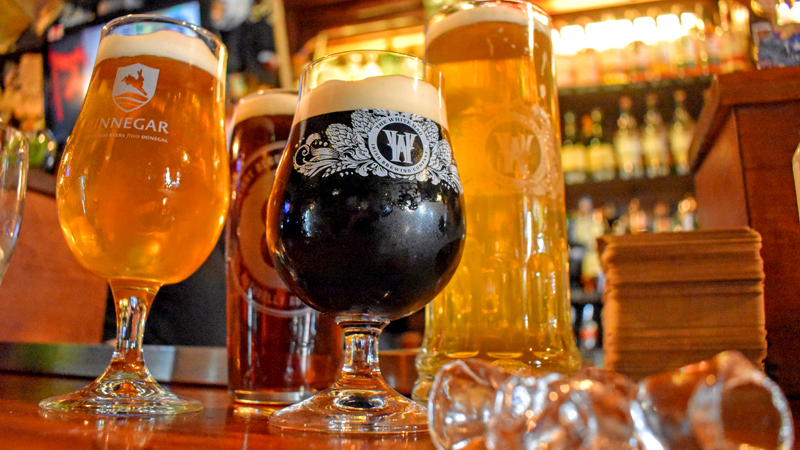
The beer scene in Ireland has long been dominated by Guinness and its subsidiaries, but in recent years that has been slowly changing with the eruption of craft breweries throughout Ireland – such as The White Hag, Lough Gill Brewery, Kinnegar, Bru, West Cork Brewing, Black Donkey, Treaty City, Porterhouse, Eight Degrees, and more. Though usually very regional, the number of bars stocking different craft brews are slowly growing. There are over 40 microbreweries in the Republic and another 20 or so in Northern Ireland. More and more, Irish pubs are stocking regional craft beers on tap and in bottle, though do keep in mind that most of these craft breweries are quite small.
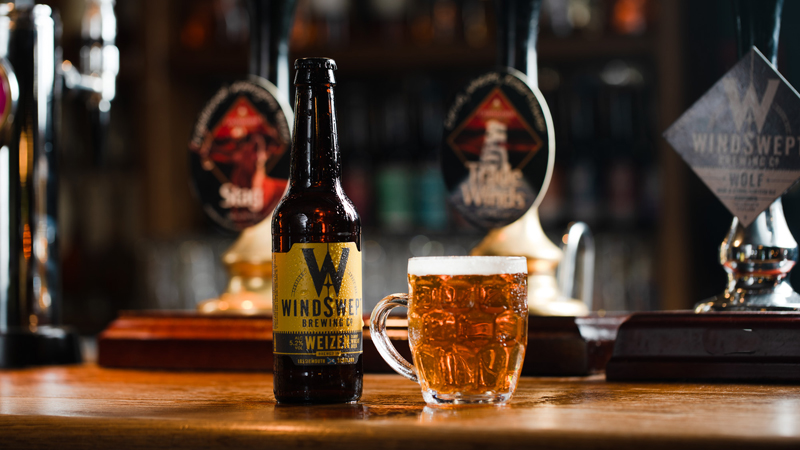
Tennents may be the most produced, consumed, and well-known beer in Scotland, but Scottish beer production has gone far beyond that in recent years. Craft breweries in Scotland have also seen a surge, with now over a 100 registered craft breweries across the country. Some breweries have gotten quite large and have international recognition such as BrewDog, Black Isle Brewery and Stewart Brewing. Other breweries, like in Ireland, are very regional, and are generally sold in the region in which they are produced. All of which only adds to the exclusivity of these tasty and unique brews.
Find your perfect Scottish pint using our interactive beer matching tool here.
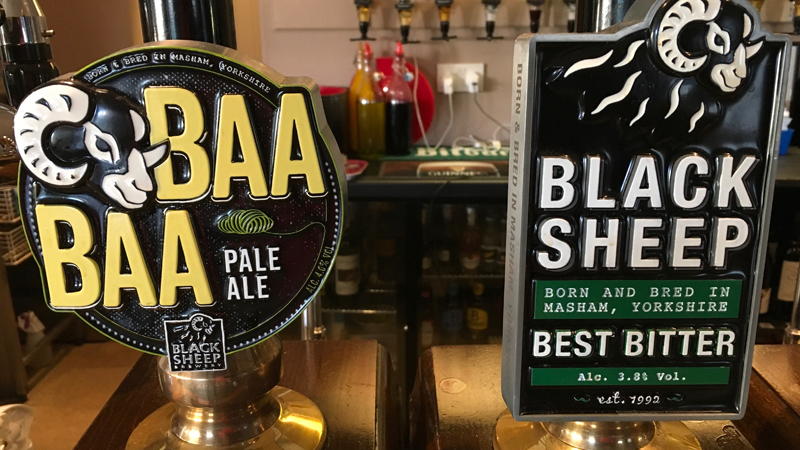
England has been brewing beer for centuries, and it is still incredibly popular. Traditional types of English beer include bitter, mild, brown, and old ale. The stereotype that English ale is famously served “warm” is a misconception – really, these ales are served at “cellar” temperature. In recent years, there has been a considerable increase in demand for craft beer, resulting in an explosion of craft breweries – today there are over 700 craft breweries across England.
![]()
Beer is fondly considered the national drink of Wales. It is no coincidence that the Budweiser Brewing Group’s largest UK brewery is in South Wales. Beer giants aside, Wales has a thriving microbrewery scene. Look for Drop Bear, the country’s first Certified B Corp brewery, and Geipel Brewing, which uses water from its own borehole. If you like a lager full of flavour and tradition – the oldest brewery dates back to the 1870s – head to Wales.
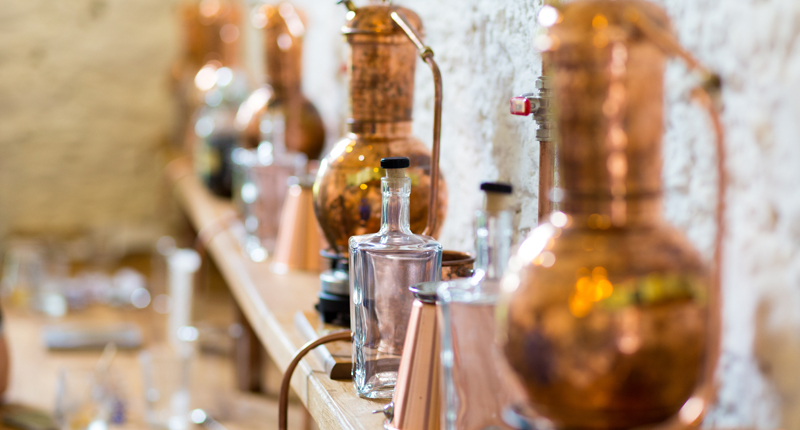
Poitín – Irish moonshine, pronounced poo-cheen – was long an illegal brew, made by farmers and other remote communities, but today, poitín is able to be brewed and bottled legally. This traditional distilled spirit from Ireland is distilled in a pot still, and the spirit of choice in remote regions of the island. It was once distilled in rural areas during windy or inclement weather so as to be far from the authorities as it was brewed without a license.
Poitín traditionally uses malted barley, though in modern times other bases have been used, such as corn or potato. Because it was distilled illegally and therefore not passing any standards, poitín quality varied quite a bit, though today, modern Poitín has to pass standards.
Though less potent today than in the past, the Irish word poit still means “hangover.”
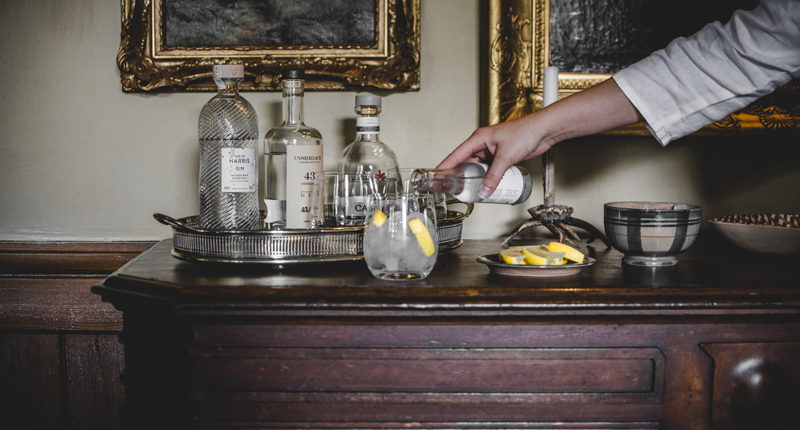
Gin is a rising star across the United Kingdom and Ireland. Distilleries such as Drumshanbo, Listoke and Dingle Gin have put Ireland on the gin map.
Scotland is more well-known for its gin with over 70% of the UK’s gin production taking place in Scotland. Many whisky distilleries also produce gin to tie over the long maturing process of whisky. This has resulted in an incredible variation of gin available in Scotland. Many distilleries use local Scottish ingredients to enhance the flavours of their gins like foraged sugar kelp from the Isle of Harris, or botanicals like roseroot and seabuckthorn that grow along the Scottish coast. Though traditionally bear drinkers, gin has also grown in popularity in recent times with several mainstream and craft gin distillers making a splash on the scene.
English gin is perhaps best known historically, with the spirit gaining a notorious reputation for causing debauchery in the 18th century. However, this rise in gin popularity left us with some of the best-known names in British gin today, including Gordon’s, Tanqueray and Beefeater.
Pimms is a gin-based liqueur and the favourite summer drink of the English. Although it was originally marketed to aid digestion, Pimms gained mass popularity as a tipple at the start of the 20th century. It’s usually served as a long cocktail garnished with fruit and is known to be very refreshing on a hot day. Alongside champagne, Pimms is actually one of the two official drinks of The [tennis] Championships, Wimbledon!
From warring giants to seals-turned-mermaids, hounds of Ulster to swans that used to be children, cackling hags and wandering witches, unicorns and lake monsters or watery horses, the rich tapestry of Irish, Scottish and English folklore is fascinating.
Scotland, Ireland, England and Wales have their own myths and legends, though there is some overlap. For example, the legend of the selkies, the seal people (the origin of the mermaid legend) who shed their ocean seal skins while on land to become humans, exists in both Scotland and Ireland.
Irish folklore and mythology is some of the richest in Europe. Not only are there many stories, they are both inextricably tied to the landscape (giving meaning and story to various rocks, hills, lakes and rivers) and they are still handed down from parent to child today. These oral stories vary depending on the storyteller and the audience, with many offshoots, differing versions, and extensions. Many characters make appearances in multiple stories.
English stories are a bit different – think Robin Hood with his merry men, or perhaps King Arthur and Guinevere and the wizard Merlin. Perhaps based on real people, these stories have become tied to what it means to be English.
Irish folklore and mythology is some of the richest in Europe. Not only are there many stories, they are both inextricably tied to the landscape (giving meaning and story to various rocks, hills, lakes and rivers) and they are still handed down from parent to child today. These oral stories vary depending on the storyteller and the audience, with many offshoots, differing versions, and extensions. Many characters make appearances in multiple stories.
But the main “pantheon” of Irish folklore comprises of Finn McCool (or Fionn Mac Cumhail), the angry giant who built the Giant’s Causeway to fight a Scottish giant; Diarmuid and Grainne, Ireland’s tragic lovers à la Romeo and Juliet; Cuchulainn the Hound of Ulster and mortal enemy of Connacht’s impressive warrior queen Queen Maeve – they fought great wars over a giant magical bull; the Children of Lir who were turned to swans for 900 years by a jealous stepmother, and Oisin, the warrior son of Finn McCool. There are many others – the Tuatha Dé Dannan are a supernatural race of beings that evolved into the sídhe (pronounced “shee”) which are what today we know as fairies (and by extension, the infamous leprechauns). There’s also the Cailleach of Beara, a divine hag responsible for winter weather – various neolithic sites are associated with her, and finally the Salmon of Knowledge. There are many lesser-known stories about Irish folklore – many of which are connected with the rolling emerald landscape itself.
Even after the arrival Christianity, it simply merged with Irish mythology – so the Gateway to the Fairy World simply became the Gateway to Hell, the pagan goddess Brigid was canonised into Saint Brigid, and many other Celtic pagan concepts, traditions and characters were simply Christianised.
Irish folklore is woven into the Irish landscape, and is an important part of the culture and tradition here. Stories are used to explain why that odd-looking rock is there, or what that ancient (Neolithic) mound is, or why a tree grew in a particular place. Storytellers are revered, and have always been so. For so long, few people could speak English or were literate, so oral storytelling became of extreme importance – and this focus and reverence put on storytelling has lead to a rich tradition of writing and a plethora of Irish authors, poets, playwrights and writers, proportional to the size of the Irish population.
Although mythology and folklore do not have as much prominence in Scottish culture as it does in Irish, there is certainly a presence. Undeniably one of Scotland’s main tourist attractions is one the world’s most famous myths, the Loch Ness monster, a dinosaur-esque beast that lurks in the depths of one of Scotland’s largest lochs.
Nessie is not the only water based legend you have to keep an eye out for when visiting Scotland. Kelpies are shape-shifting spirits said to live in Scottish lochs and rivers. Most commonly they are said to take on a horse-like form, but in some stories they take the shape of a human to lure people to their watery deaths. It’s believed these stories were told to warn children to stay away from deep water. You can visit the impressive Kelpies monument near Falkirk, consisting of two 30-meter high horse-head sculptures. It should be noted that the monument acknowledges Scotland’s horse-powered past and not the mythological creatures…
Scotland’s the perfect destination for a bit of “dark tourism”; with the cities, castles, and even countryside roads laden with ghost stories. For those brave and keen you can take a tour in Edinburgh’s underground city, a former neighbourhood and slum gradually overtaken by larger structures and sealed during a spread of bubonic plague. The vaults are now rife with ghosts, the most famed being a little girl looking for her lost teddy bear. Other famous ghostly hotspots include Drovers Inn along the West Highland Way, said to be the most haunted pub in Britain, and Glamis Castle, home to 4 frequently sighted ghosts.
You can’t talk about Scottish myths and legends and not mention unicorns. This mythological beast is Scotland’s national animal. Exactly how this came about is unknown, but unicorns share a lot of characteristics with the Scots. Proud and untameable, yet simultaneously being a symbol for purity and strength. It’s said that Scottish kings fancied themselves unicorn tamers, as unicorns were believed to only yield to virgin maidens as pure and innocent as the beasts themselves. This is why the unicorn is often depicted by the Scottish with golden chain wrapped around its neck or body. It was the ultimate representation of power.
The most famous stories to have come out of England are that of King Arthur and Robin Hood.
King Arthur is a timeless hero – usually associated with the early Middle Ages, but he could have been around even earlier. He may be real – or just a story – or a combination of both. The story is legendary – a peasant boy destined to become king, demonstrating his right to rule by pulling what is likely the most famous sword in history, Excalibur, from a stone.
From there, the boy Arthur is crowned king, and he becomes the epitome of the ideal and chivalrous king, with his Knights of the Round Table, his noble quests, his beautiful bride Guinevere, all under the tutelage of the famed wizard Merlin.
The other historically significant myth to talk about is Robin Hood. This lord-turned-thief is infamous for his mantra of “steal from the rich and give the poor.” He and his band of merry men live in Sherwood Forest, planning their light-hearted attacks on wealthy caravans in order to provide for those less fortunate. They were hunted by the evil Sheriff of Nottingham, who represents authority, and wealth disparity.
Both of these stories are important because of how they portray medieval English history – and provide two figures with whom the English could identify – a sort of national hero drawn from, and for, the lower classes – a glorification of what it means to be English.
Learn more about English culture and traditions in this article that covers castles, iconic landscapes, the Royal family and much more.
![]()
In Welsh folklore, a treasure trove of enchanting tales and mythical creatures awaits. From y Tylwyth Teg, the fair folk, to the iconic red dragon, Wales is steeped in the supernatural. Here, ancient legends intertwine with the fabric of the land.
One example is the red and white dragons. In the 5th century, Vortigern, a Celtic king, chose Dinas Emrys as the site for a new castle. Every day, workers built the foundations. Every night, their work disappeared. Puzzled, the king consulted magicians, who suggested the ground be sprinkled with a child’s blood. Not just any child, but one born of a human mother and a father from the Other World. After a great search, such a child was found. He was Merlin, the powerful wizard of Arthurian legend. Merlin reveals there are two dragons sleeping under a mountain lake. Once disturbed, the sleeping dragons – one red and one white – wake up and begin to fight. The red dragon wins, returning to sleep in the mountain to this day. While this tale feels steeped in mythology, excavations in the 1940s revealed a lake and 5th century fortress!
800 years later, this area within the Eryri (Snowdonia) National Park was the site of another Welsh legend. Llywelyn, a prince, lived in this historic region of north Wales. He went hunting one day, leaving his loyal dog and baby at home. Upon his return, Llywelyn is greeted by his dog, Gelert, covered in blood and his baby missing. Horrified, the prince slays the dog with his sword. The dog lets out a final bark, and the baby cries out. Llywelyn finds his baby safe near the body of a huge wolf – Gelert had slain the wolf and kept the child safe. Struck with grief, the prince erects a grave for the dog. Today, Gelert is immortalised in the name of the charming village around his grave, Beddgelert – Gelert’s grave.
The country’s patron saint was born around 500 AD at the other end of Wales. St David is the only native-born patron saint in mainland Britain – although Ireland’s three saints were born across the UK & Ireland. St David became a renowned teacher and preacher in 6th century Wales, performing many miracles. He established a monastery where St Davids, the smallest city in the UK, stands today. 1st March is celebrated as St David’s Day in Wales and beyond.
Other key dates in the Welsh calendar include Mari Lwyd (mid-winter), nos Calan Gaeaf (31st October) and Heuldro’s Haf (the summer solstice).
Welsh folklore is a testament to the enduring power of storytelling, connecting the present with the rich tapestry of the past. Walk through this dramatic landscape to see a country shaped by legend.
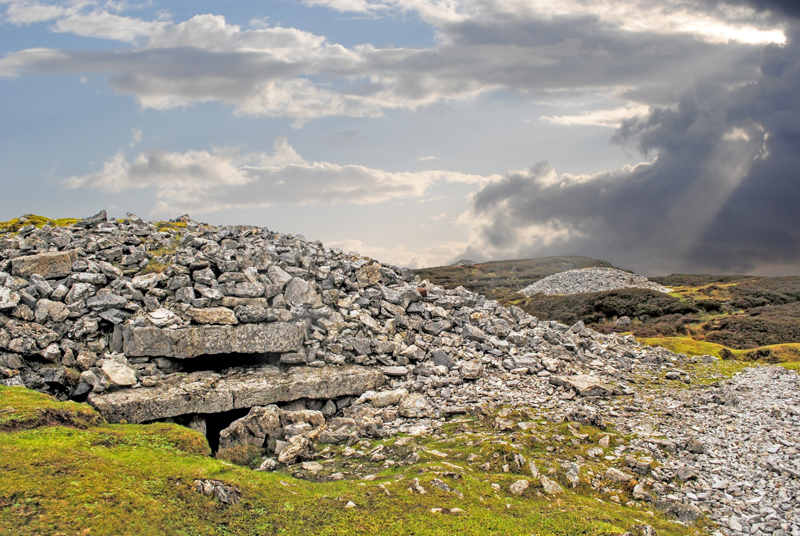
Going back a few thousand years, Neolithic peoples inhabited both Scotland and Ireland, the world’s first farmers. These ancient people who lived some 5,000 years ago built amazing monuments. In Scotland, the bulk of these ruins are on the islands – the Orkney Islands and the Isle of Lewis and Harris. In Ireland, the entire island is bursting with these ancient tombs and monuments.
Newgrange in the east, not far from Dublin, is the largest monument, but the west of Ireland has the highest concentration of stone circles, cairns, portal tombs, wedge tomes, court tombs and standing stones.
In the northwest, find Carrowmore and Carrowkeel, two of the largest collections of Neolithic cairns, tombs and stone circles, with dozens on each site. Carrowkeel’s main cairn is aligned with the Summer Solstice sunset – an amazing experience.
Visit the Poulnabrone Dolman, a massive dolman that is the pinnacle of the Burren’s rich archeology.
In the south, visit Lough Gur for the largest stone circle in Ireland, also aligned with the summer solstice.
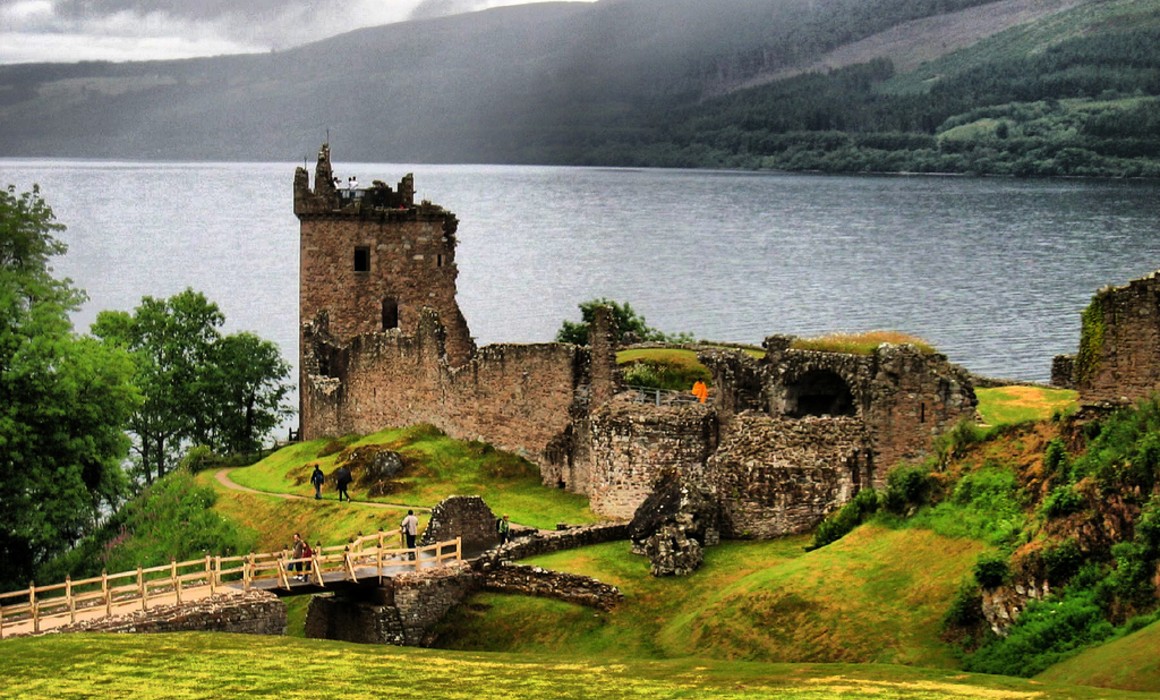
If you want to visit a historic castle then Scotland is the destination for you. Scotland is home to between 2,000-4,000 castles, which range from elaborate palaces, great houses, stately mansions, intimidating forts, impressive strongholds, lonely towerhouses and imposing keeps. Scottish castles are all drama, often formidable structures or ruins set in jaw-dropping scenery. Many castles come with a fascinating backstory of clan disputes and battle. Often they’ll even feature a residential ghost or two.
Hundreds of castles are open to the public, and along with tours of the interior, there will also be beautiful gardens begging to be explored. If you want to spend a day or two living like royalty, there are various castle hotels dotted around the country and also private hire opportunities.
![]()
The Roman Republic started in what is modern-day Italy in the 6th century BC, not expanding off the Italian peninsula until the 3rd century BC. It took some time for them to start expanding, but once it became an empire, each of the ruling emperors were expected to do two things – leave their mark on Rome (and try to outdo your predecessor), and expand the empire.
Contrary to popular belief, the Romans started on good terms with the Celtic tribes living outside their walls. They traded with them all manner of objects, though later unrest was a factor in the Romans decision to leave Britannica. Regardless, a fear of invasion from the north led to the building of the impressive Hadrian’s Wall in 122 AD, and running for 73 miles across England.
One of the most important places in Roman Britain was York, known as Eboracum in Roman times. Founded by the Romans in 71 AD, it was the north’s major military base and therefore a significant city.
The Romans stayed in England for about 360 years, from 43 BC to 410 AD. Though Hadrian’s Wall is the most famous, they built other great monuments too, such as Bath spa, using the natural thermal waters found in the area. Today the Roman bathhouse is a historical site but there is a modern bathhouse next door, still using the natural waters.
Fáilte go hÉirinn – Welcome to Ireland in Irish
Fàilte gu Alba – Welcome to Scotland in Scots Gaelic
Another area where Ireland and Scotland both share common heritage and yet differ in today’s society is through the use of language. Both Ireland and Scotland’s vernacular languages (Irish and Scots Gaelic, respectively) share a common ancestor. Both languages were repressed throughout history by the former governments, and both languages suffered regular attempts to be stamped out. Both languages exist as principal spoken languages in scattered pockets, usually in the more far-flung regions of the country and particularly amongst island communities. There has been a shift towards reviving these languages in recent years, and more people are becoming bilingual in both English and their historic native language.
The Irish language has seen a massive revival in Ireland. There are still a good few pockets of native Irish speakers, called the Gaeltacht, which are found predominantly on islands or in remote communities in West Cork, Dingle, Connemara, the Aran Islands, and northern Donegal. In Scotland, there aren’t as many pockets of Scots Gaelic speakers.
Where Scotland and Ireland really differ in terms of language is that in Ireland, Irish is a required subject from primary school all the way up through the Leaving Certificate (a level comparable to the US SATs, British A-Levels and French baccalauréat). There are even plenty of Irish schools where all subjects are taught in Irish.
Though most people don’t hold Irish conversations daily, nearly everyone in Ireland is conversational in Irish, and they do tend to weave in small amounts of Irish in everyday dialogue, emails salutations and exchanges. All signs and official documents or websites are translated into Irish, and there are certain TV and radio channels that are Irish-speaking only. In Scotland, though these Scots Gaelic pockets do exist, the extent is not the same, and it is not yet a compulsory subject in schools.
Speaking traditional Scottish Gaelic was outlawed in the 1600s and was further suppressed in Scotland following the Jacobite uprisings and Highland Clearances. Unsurprisingly, Scots Gaelic is now a dying language. Efforts have been made to revive the language, with dedicated radio and TV stations, and subsidized degrees, but many argue that government intervention is required to save it.
The good news is that the language is seeing a recent surge in popularity. Language learning app Duolingo launched Scots Gaelic as a learnable language in November 2019, and it saw over 127,000 registrations in a short period of time. This made Scots Gaelic one of the fastest-growing language courses ever on the app, and it means that more than double the number of people who currently speak it are learning to. TV shows like Outlander and other recent portrayals in film have added to the re-popularisation of Scots Gaelic, with many outside of Scotland learning the language as well.
Cymraeg, the Welsh language, weaves a melodic thread that binds the cultural tapestry of Wales. With its lyrical lilt, the Welsh language is a testament to the enduring spirit of the Welsh people. Welsh is one of the oldest languages in Europe and the oldest written language in the continent, apart from Latin and Greek. In use continuously since its inception from Brythonic, the language has a challenging history. As with all Celtic languages, Welsh has been penalised throughout history. In the 1500s, King Henry VIII prohibited the use of Welsh in public administration and the legal system. This ruling formed part of the ‘Act of Union’ between England and Wales. Shortly after, all public worship in Wales had to occur in English. As recently as the 20th century, the Welsh Not system penalised children who spoke Welsh in some schools. The punishment included wearing a wooden sign around their neck. Fortunately, the language survived. Today more than a quarter of the population of Wales can speak or use Welsh. This percentage is higher in children as the language is taught in schools, giving hope for preserving this ancient language. Especially in north Wales, expect to see Welsh on every street sign and listen out for conversation in the language.
Sign up for our newsletter and be the first to hear about trip news, blogs and offers.